Alec Guinness Disappears Into Nearly A Dozen Roles In Three Classic Ealing Comedies
KIND HEARTS AND CORONETS (1949)/DIRECTED BY ROBERT HAMER
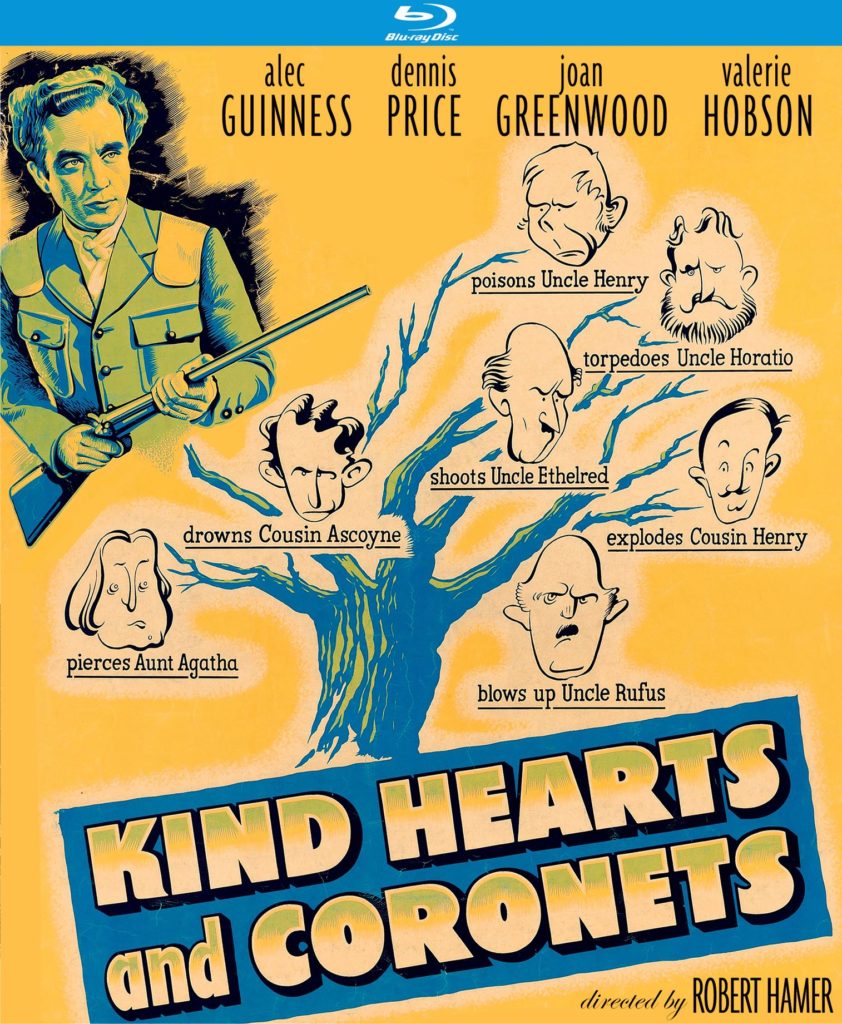
THE LAVENDER HILL MOB (1951)/DIRECTED BY CHARLES CRICHTON
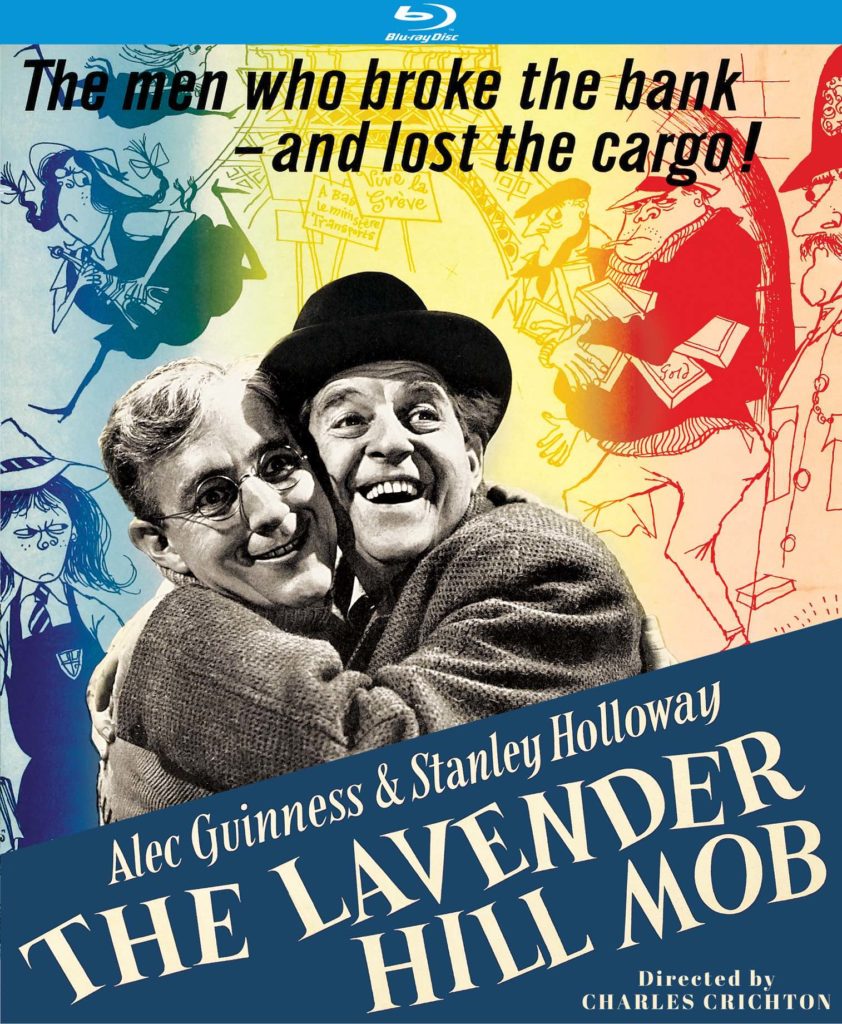
THE MAN IN THE WHITE SUIT (1951)/DIRECTED BY ALEXANDER MACKENDRICK
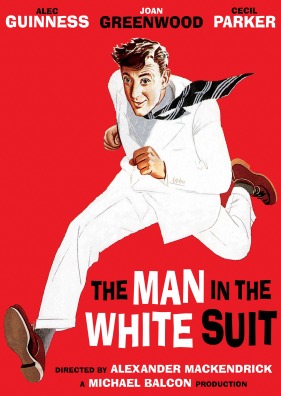
STREET DATE: SEPTEMBER 3RD, 2019/KINO LORBER STUDIO CLASSICS
The reviewer is honored and delighted to announce the September release of three magnificent Ealing Studios comedies starring Alec Guinness. The protean actor essays no less than eleven roles between three films, admirably presented by Kino Lorber Studio Classics, that comprise the comic crème de la crème of British postwar filmmaking. Beginning with 1947’s newspaper satire Hue and Cry, continuing through 1949’s clever suburban secessionist Passport to Pimlico, and roaring through the off-rail line tributaries of 1953’s The Titfield Thunderbolt, Ealing’s sterling comedy productions — announcing their unmatched wit, charm, and ingenuity with an oval-shaped logo wreathed by simple ivy — described and defined their corner of the world with a universality born of their very provinciality.
And no actor better personified their limitless possibilities — a universe contained within a global area relative to the size of a postage stamp — than Alec Guinness. Having made his supporting film debut in David Lean’s 1946 Great Expectations, the stage actor took gradual hold on the British public imagination — raising his profile considerably, for good and ill, in the role of Fagin in Lean’s subsequent Dickens adaptation Oliver Twist (1948) — which solidified with the actor vanishing into nine members of the aristocratic D’Ascoyne family in 1949’s Kind Hearts and Coronets. The most astonishing point of the character actor’s unprecedented ascension to Britain’s top box office draw in 1951, with the summer-bordering release of The Lavender Hill Mob and The Man in the White Suit, is that Alec Guinness had yet to repeat himself in any role taken theretofore in age, personality, or appearance.
And nor would he. The half dozen films Guinness made for the studio during its period of greatest artistic productivity, climaxing for both actor and studio in 1955’s cozy black murder farce The Ladykillers, represent a comprehensive style of comedy perfection irreducibly and indefinably British.
Alec Guinness And The Ealing Style
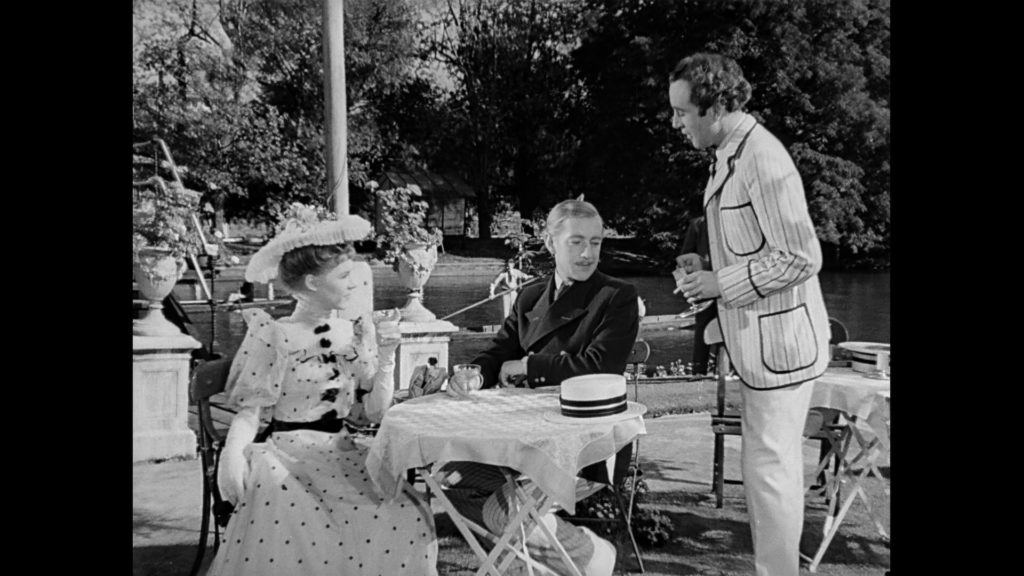
In the summer of 1951, British film audiences saw one actor play both an invisible insider and a glaring outsider. That Alec Guinness was utterly convincing in both roles, and that these two very different comedies remain identifiable with a style born of impeccable realism, shows a match between performer and production where character and setting effectively become mutually indistinguishable. Pasty and middle-aged in The Lavender Hill Mob and breathless and driven in The Man in the White Suit, Henry Holland and Sidney Stratton have little in common besides the alliteration of their names and their all-important private dream which both succeed, to varying levels, in making a separate reality. But like the Banker D’Ascoyne who sympathetically expresses regret for a wrong once committed against his young assistant’s mother and the Duke D’Ascoyne who monstrously sets mantraps for starving poachers a few scenes later — both played by the same chameleon-like actor — Alec Guinness and Ealing Studios in 1949’s Kind Hearts and Coronets set a pattern for ill-matching yet undeniably complementing characters and scenes that never ring one even-toned dinner bell less than true.
Although the studio became most internationally famous for its comedies — particularly those made in the first decade after World War II — Ealing under producer Michael Balcon made adventure films (Scott of the Anarctic [1948]), patriotic war films (The Cruel Sea [1953]), costume dramas (Sarabande for Dead Lovers [1948], poetic romances (It Always Rains on Sunday [1947], and even dabbled in film noir (Nowhere to Go [1958]). Indeed, that the studio’s best-known film of The Lavender Hill Mob should have arose between screenwriter T.E.B. Clarke having written one grim-faced police procedural (1950’s The Blue Light) while doing research for an armored car heist film (1951’s Pool of London) may show the studio’s variety of output that occasionally, and almost accidentally, settled upon comedy.
But it was in their comedies that the studio truly shone, offering a level of perfection in writing and performance that simply could not be matched outside the artistically fertile, postwar environment of Great Britain. (As a parenthetical, one might wonder how the studio’s strongly collegial atmosphere might have been further applied to that other uniquely British genre, that of horror, had Ealing made more than one. But the one horror-anthology film the studio did make was nothing less than perfect: 1945’s truly terrifying and astonishingly accomplished Dead of Night.) The soft shuffling of weary feet on a shabby boarding house welcome mat, a furtive pour of sherry concealed from a wife’s disapproval in a mismarked photochemical decanter, falling at breakneck speed off a luxury car’s running board and nevertheless proceeding (without a moment’s pause for breath) with a lengthy description of polymolecular revolution; in many guises, styles, and voices, Alec Guinness and Ealing Studios brought their little corner of the world on now seventy-year display for the rest of it.
KIND HEARTS AND CORONETS (1949, dir. Robert Hamer)
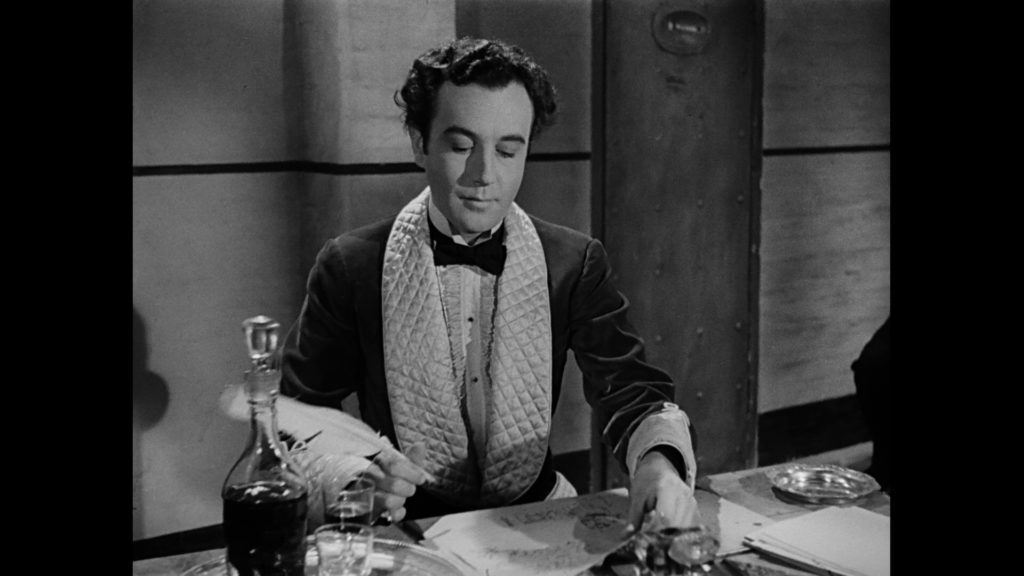
A Machiavellian social climber murders six of his near relations and mortally maneuvers past two more in order to attain a 250-year-old dukedom. Also romantically wavering between two very different women, one as deliciously wicked as himself (Joan Greenwood) and the other as equally poised as his own cultured bearing (Valerie Hobson), the divided nature of this attractive psychopath earns our sympathy and even admiration as he engages in yet another clever play of ingenious homicide. This lush Edwardian comedy of manners, in which its audience delights in the anti-social antics of an elegant serial killer, is as lovely as it is deadly; a charming evocation of the ease and grace of British aristocratic traditions embalmed by the early twentieth century.
Director Robert Hamer and co-writer John Dighton liberally adapt Roy Horniman’s 1907 Israel Rank: The Autobiography of a Criminal, downplaying the grisly aspects of its source material, changing the half-nationality of its protagonist from Jewish to Italian, and emphasizing the light and sunny qualities of merry old murder with the lace-frame prettiness of a more than century-old picture album. Nominal star Dennis Price is picture perfect in this lace-frame configuration as Louis D’Ascoyne Mazzini: the future tenth duke of Chalfont whose eventual occupation of that landed country estate is sartorially unruffled — and as even-toned as his eloquent narration — by the drownings, poisonings, explosions, balloon arrow-piercings, and point blank-range hunting rifle-decapitations that precede it.
All of which might be in very poor taste were the many family victims not enacted in their several ages, occupations, and even sexes by the incomparable Guinness. From a torpedoed naval admiral going down with his own ship — beard foaming in the salty brine — to a window-smashing suffragette — long hair valiantly streaming in the aerial breeze — the distinct impressions left by each of the murdered D’Ascoynes play like cameoed views hand-sewn in successive parlor-friendly patterns.
As bordered in blood red, of course. And although Douglas Slocombe’s peerless black-and-white photography — as suggestive of its timeless era as the suburban drawing rooms, boating vacation spots, manorial armor galleries, and prison chambers we move through — cannot literally present that color visually, it is nevertheless suggested through the vivid reality of inexorable intent further filling the D’Ascoyne family vault with each death knell of its chapel bell. Improbably fun and charming from the Mozart aria that both begins and ends this beguiling excursion into the lighter side of homicide, it is absolutely no exaggeration to say that in every term of performance, storytelling, and filmmaking, Kind Hearts and Coronets is murder done right.
THE LAVENDER HILL MOB (1951, dir. Charles Crichton)
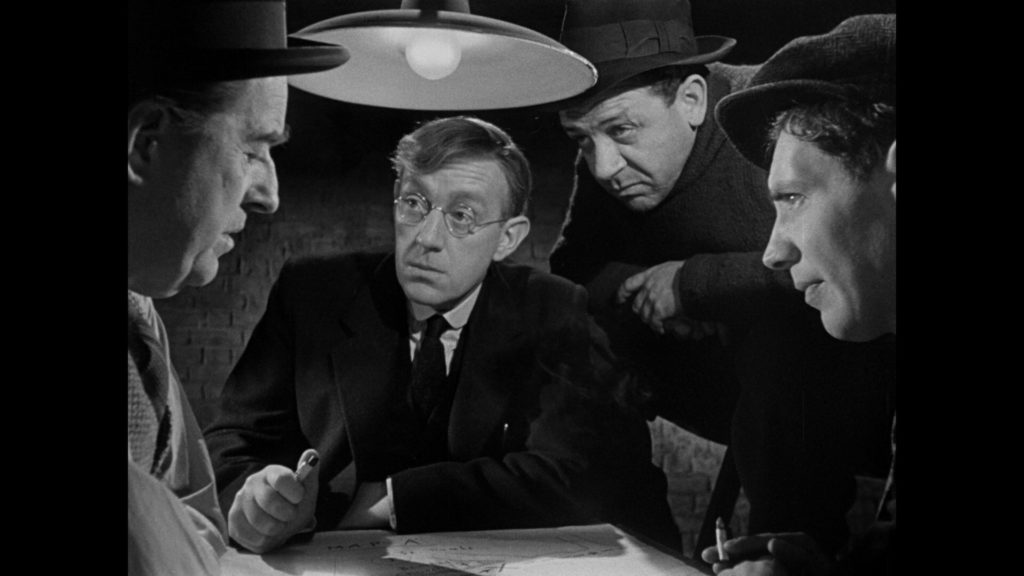
A quiet boarding house in a sleepy suburban section of London conceals the ruthless ambition of a criminal mastermind in the pasty, portly form of a bespectacled, middle-aged security officer. Daily arriving to work with his bowler hat and umbrella in a pedestrian sea of like-dressed men, this featureless figure has ridden every morning for the past twenty years with armored vans containing a million pounds in gold bullion bars, while privately dreaming up fanciful schemes to divert just one such transport towards a carefree spree in colorful South America. A new boarder in an art enthusiast and souvenir-maker inspires a foolproof means to conceal the ill-gotten gold in successively unassuming Eiffel Tower statuettes, and with two Cockney career criminals (Alfie Bass, Sid[ney] James) form Lavender Hill’s most unlikely quartet of crooks.
Director Charles Crichton and screenwriter T.E.B. Clarke take scenic, sociological, and psychological advantage of Britain’s postwar era of rationing and rebuilding for under 90 minutes of similarly condensed and utterly refined comic anarchy. Like the flick of a molten gold fleck on the tip of an umbrella, from which a socially transgressive idea is born, the sly smile of a nine-to-fiver similarly imparts the private glee of a publicly restricted, hemmed in, and bound up worker bee who has just realized that he has taken his last tea break.
Here, Alec Guinness as meek, unassuming Henry Holland suggests the socially retiring revolutionary with each shy stammer, furtive glance, and difficulty pronouncing his ‘r’s. Matched by expansive character actor Stanley Holloway as Shakespeare-quoting sculptor and fellow Lavender Hill boarder Alfred Pendlebury, “Dutch” and “Al”, as they privately call each other, make their criminal dream a hilarious reality — from a post-robbery plunge into the Thames to a swift scurry down the swirling stairs of the actual non-gold-miniaturized Eiffel Tower — through the very qualities that made Ealing Comedies so special: namely, again, an ever-escalating storyline and lovingly-drawn characterizations encompassing wit, charm, and ingenuity.
Still the most popular and well-known among all the memorable comedies produced at this quietly unassuming film studio, nestled in an unfashionable London suburb to boot, The Lavender Hill Mob retains its universal appeal by perfectly capturing its deceptively small corner of the world in recognizably human terms and then setting its most unwilling captor free. For a time, that is. Following a breakneck car chase down the city center, as “Dutch” climactically disappears down one final stroll in a crowd of (former) fellow wage slaves, the shy, stammering, paunchy, and bespectacled hero breaks out of his socially imposed restrictions and fulfills the promise — albeit temporarily — of that magnificent run down the Eiffel Tower steps: namely, finally, that of South American dream-escape.
THE MAN IN THE WHITE SUIT (1951, dir. Alexander Mackendrick)

A once promising Cambridge chemist bounces between textile mills in the North of England in obsessive pursuit of a polymolecular formula that will revolutionize the clothing industry. Infiltrating the powerful Birnley plant from its shipping department, the familiar test tubes, beakers, and gurgling flow of liquid luminescence first captures the attention of the plant owner’s daughter (Joan Greenwood), and later the plant owner himself (Cecil Parker), who personally places his entire fortune at this scientific rebel’s literal (exploding and factory-destroying) disposal. Eventually dissolved in solution at the brightest end of the light spectrum, the apparent stability of the chemical compound is at once test-manufactured in a glowing, indestructible, and dirt-repellant suit of clothes proudly worn by its inventor. Laundry will be a thing of the past; but so too, the workers and owners soon realize, will be buying new clothes.
Director Alexander Mackendrick brought an unproduced play by Roger MacDougall to the attention of Ealing Studios producer Michael Balcon, who quickly saw its potential for the screen. Co-adapting with the playwright and screenwriter John Dighton, Mackendrick turns a keenly satirical eye on the baffling effect of real innovation on the always fraught relationship between labor and capital. Transforming two natural enemies into allies, as hilariously suggested by the black-furred, asthmatic, and vulture-like appearance of textile industry titan Sir John Kierlaw (the memorably desiccated Ernest Thesinger), all clothes-makers turn sharply in near-deadly opposition to the man of scientific progress who will rapidly render them — from the owner Birnleys to the palatte-shifting Berthas (Vida Hope) — entirely irrelevant.
As the inveterate inventor monomaniacally marked by the unmistakable glow of true progress, Alec Guinness’s lean, hungry look of maligned martyrdom wonderfully captures the wild-eyed fanaticism of his character’s untarnished bearing. His Sidney Stratton single-mindedly chases polymerized fantasies made reality by hard-drive and self-sacrifice without once stopping to consider its effects on clothiers or consumers — essentially, everyone. When chased down in the night by colleagues and bosses alike — Stratton’s sartorially streaking beacon of light a sardonic inversion of shining heroism — it is only his landlady’s rueful complaint of losing her weekly “bit of washing” that gives Sidney a moment’s pause.
The Man in the White Suit takes the quiet suburban rebellion of its summer predecessor one step further by equally and unassumingly venturing upon social upheaval and chaos. The polite dust-up, or dust-off, if you will, rather too patly resolves itself with the defeated Stratton wistfully wandering away from the factory… until, that is, the once more familiar gurgling and burping sounds of scientific revolution triumphantly (for him), tragically (for us) fill the soundtrack of his mind yet again.
…
If unfamiliar with Alec Guinness’s work outside of his having most world-famously enacted the role of a “crazy old wizard” laser-dueling a black-armored Frankenstein cyborg, Kino Lorber presents a refreshingly different trilogy, here of postwar British comedies, that will, one hopes, give new appreciation for the actor’s universal talents outside of that ongoing series of space operas. These rich, evergreen comic perennials — whose influence has been felt in everything from Monty Python and Douglas Adams to the cinema of Mike Leigh — receive appropriately pellucid transfers to high definition, with sound mixes to match frequent Ealing composer Georges Auric’s brass fanfare over the studio’s iconic logo.
The importance of these productions both historically and artistically are highlighted by several documentaries and interviews, including brief, former DVD release introductions on Kind Hearts and Coronets and The Lavender Hill Mob by filmmakers John Landis and Martin Scorsese, respectively, and archival interviews on the same discs with cinematographer Douglas Slocombe — who photographed all three films, and then went on to become one of the most sought after international cinematographer through the late 1980’s — and director Charles Crichton — whose career faltered after his close association with Ealing Studios before triumphantly rebounding (in his 70’s!) with 1988’s A Fish Called Wanda.
Also included is a 1990’s TV program on the eventful working and personal life of Kind Hearts and Coronets star Dennis Price that offers a valuable look at a once promising actor whose career deserves to be better known. Screenwriter T.E.B. Clarke, whose originality and keen sense of character and setting contributed much to the emergence of a recognizable Ealing comedy style, reflects on his own involvement with the studio in a 1970’s TV interview, where the casual wit very much comes across like a retired Henry Holland charmingly resting on deserved laurels of long and varied anecdotal incident. Rounding out the talking heads features is a 15-minute program entitled Revisiting The Man in the White Suit, where filmmaker Stephen Frears and historian Ian Christie discuss and analyze the legacy of this still timely social and political satire.
But where Kino Lorber truly outdoes itself, as always, is in their audio commentaries, and between Kat Ellinger, Jeremy Arnold, and Dr. Dean Brandum offers three distinct yet complementing approaches to the Ealing style and shape-shifting actor who variously embodied it.
On Kind Hearts, Ellinger comes prepared with a wealth of information on the film’s (very different) source material, the eerily similar career trajectories of director Robert Hamer and star Dennis Price — whose separate yet integrated brilliance on the film represented an artistic pinnacle for both — and of course the almost peripheral presence of cinema’s first star character actor as the nine separate D’Ascoyne victims.
Jeremy Arnold looks at The Lavender Hill Mob from the unique perspective of its domestic and worldwide distribution patterns, making a compelling case for how the Ealing comedies made a lasting impact on audiences outside the UK precisely where the vast majority of the studio’s output — costume dramas, crime films, romances, actioners, etc. — remained unseen and unknown.
Finally, Dean Brandum brings a strongly analytic eye to his feature-length discussion of The Man in the White Suit, tracing the acerbic vision of director Alexander Mackendrick (whose own career pinnacle, in addition to being a financial debacle, came later in Hollywood with 1958’s The Sweet Smell of Success) through Alec Guinness’s uncompromising Sidney Stratton and his chemically destructive tear through the startlingly thin and fraying social fabric.
Following some 3,000 inadequate words, the reviewer nonetheless remains honored and delighted to have had the chance to himself reflect on and articulate the many unique qualities of the Ealing comedies and its greatest star. In their many guises, styles, and voices, the films remain as satisfying and entertaining as an evening’s libation at the studio’s famously nearby Red Lion — a pint or two of prime Guinness washed down to brilliant screen effect in the still bracing company of Tibby Clarke, Douggie Slocombe, and all the talented other Balcon Boys.
The images used in this review, with the exception of the cover image, are credited to DVDBeaver. Thanks to Kino Lorber for providing Blu-ray copies.


